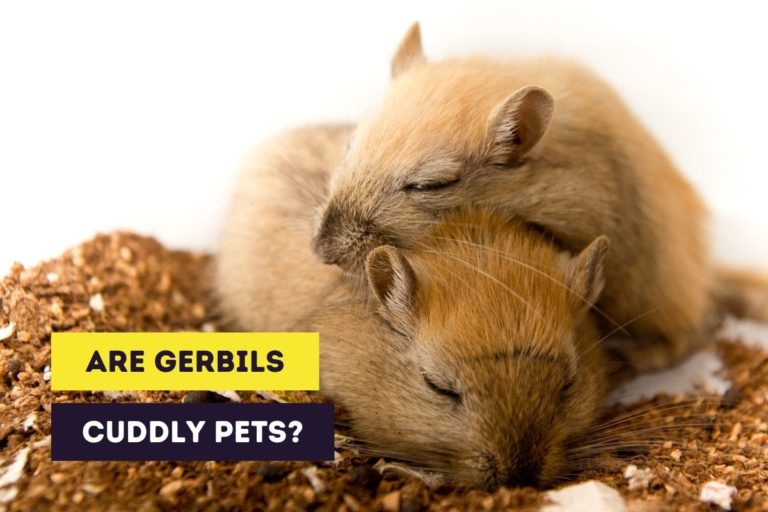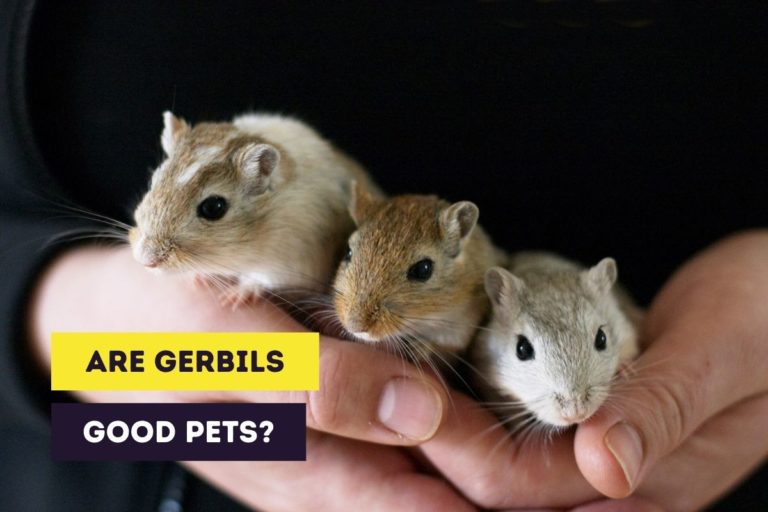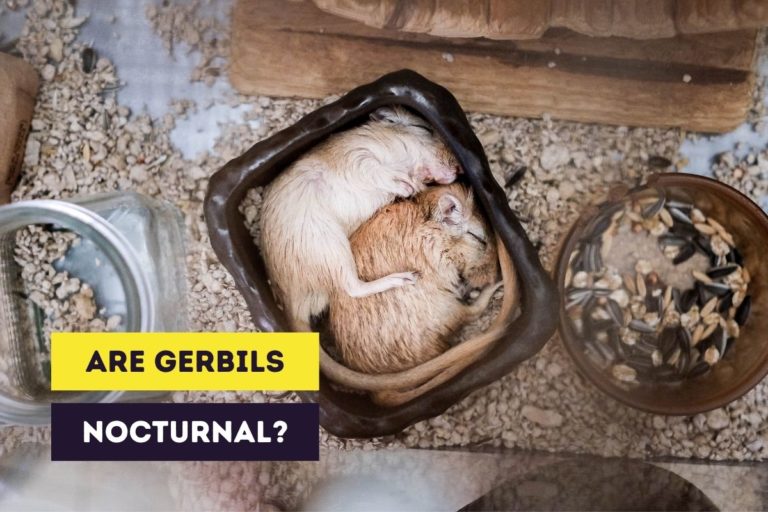Social Behavior of Gerbils (Keep Alone or Together?)
When you go to a gerbil breeder or pet store, you’ll notice that gerbils are kept in groups. But some people are scared of caring for more than one pet and want to get just one gerbil. Can you keep a gerbil alone or should they be kept in groups?
Gerbils are social animals that live in groups in the wild. In general, it’s recommended to keep at least a pair of gerbils. There are some rare cases where a gerbil is (temporarily) kept as a solitary pet. In that case, you’ll need to provide your gerbil with a lot of attention.
The term “gerbil” in this article refers to the Mongolian gerbil, the most popular pet gerbil. Gerbils are group animals that love to spend time with other gerbils. They’re not used to living alone like some pocket pets or reptiles like a crested gecko.
I would highly recommend that you get at least a pair of gerbils. Caring for one gerbil can even be more difficult than caring for a pair or small group of gerbils.
Of course, keeping group animals pose a different set of possible difficulties than keeping a solitary pet. They might fight each other, not like each other and it can – if you get a male/female pair – result in gerbil babies.
In this article, you’ll learn why it’s best to keep at least a pair of gerbils, how to keep them from fighting, how to let your gerbils adjust to a new gerbil, and what to do if you want to house only a single gerbil in your home.
This site contains affiliate links to products we recommend and use ourselves. We may receive a commission for purchases that you make through these links. If you’re interested in learning more about our affiliate links, please visit our (affiliate) disclaimer.
Social Structure in the Wild
Wild gerbils live in small groups that usually consist of one dominant breeding pair and their offspring. Groups can consist of up to 20 gerbils and form something which is commonly known as a “clan”.
The gerbil world is, like the degu world, based on hierarchy and dominance. When the group gets larger there can be fights for dominance which results in injuries and sometimes death. Usually, the clan will split up and a new clan will be created with another dominant breeding pair.
Although fighting can occur, the gerbil life is all about living in a community. A couple of examples that show their co-working/co-living behavior in the wild:
- gerbils keep each other warm by snuggling and sleeping together;
- they dig burrows together;
- gerbils will groom each other.
The group offers a lot of other advantages for the gerbil. It’s been noticed that larger groups are better at detecting predators and notifying the rest of the group. Larger groups also result in more foraging time and are better at digging burrows.
Keeping Multiple Gerbils
Gerbils are social animals and thus should have at least one friendly gerbil companion. It is usually easiest to buy and keep them in pairs. Introducing the third gerbil to a pair that has already bonded may result in the newcomer getting bullied or injured during a fight.
Same-sex pairs
I highly recommend that, if you decide to get gerbils, you get at least a pair. Gerbils are very social animals that will thrive in small and large groups but can as easily be happy with just one other companion.
The final number of gerbils you’ll house is of course determined by several factors like:
- the housing space,
- the time you have to take care of your gerbils,
- and whether you want to breed and raise baby gerbils.
If you haven’t got a lot of space, only get a pair of gerbils of the same sex. The following combinations of gerbils will work out most of the time:
- male siblings when not housed with a female gerbil
- female siblings
- a mother and her daughter(s)
It’s also possible to house a pair of males or females that are not related if they’re kept together from a young age. Older gerbils will need to go through a process of introduction with a “split tank” technique to get used to each other.
Male and female pairs
There are some people that don’t recommend keeping males and females together unless you’re planning to breed gerbils or had them desexed. If you house multiple males and females together you risk that they will start fighting each other to establish a hierarchy. I wouldn’t recommend getting a male and a female if this is your first experience with gerbils. Get two siblings of the same sex, as mentioned above.
If you do decide to keep a male and female or multiple males and females, you should:
- make sure that the cage is large enough for the number of gerbils
- have a good ratio of males and females
- neuter the males if you don’t want to care for gerbil babies
How to Help a Gerbil Adjust to Another Gerbil
Gerbils are social animals and you probably got at least a pair of gerbils. If you decide that you want to have a larger group of gerbils or got a single gerbil and decide to get him or her a companion, you’ll need to take a couple of steps to introduce the gerbils to each other and get them to like each other.
Young gerbils (younger than 8 weeks old) are a lot easier to introduce to each other than older gerbils. It’s possible that your older gerbil doesn’t accept a new companion. In such a case, your older gerbil can live alone for the rest of its life. The following techniques can help to make the introduction process a lot easier but it’s still possible that both gerbils still don’t like each other no matter what.
Using the “split tank” technique
When you need to introduce gerbils to each other the most common and perhaps the safest way to do so is the “split tank” or “split cage” technique. This technique involves putting a cage partition in the cage that separates the cage in two spaces.
Make sure that each space has its material:
- food bowl
- water bottle or bowl
- bedding material
There shouldn’t be any toys in the entire cage. The point of the separated cage is that both gerbils can see and smell each other and can get used to living in the same cage.
Basic principles of the “split cage” technique
- keep the gerbils in the partitioned cage for a week
- switch each gerbil from side several times a day
- only take the partition away when your gerbils are friendly towards each other
- always use leather gives and keep the partition in the vicinity when taking away the partition
Using the “introduction tank” technique
Another technique is the “introduction tank” technique where gerbils are put in a small cage, like an Exo Terra Faunarium, together without any separation. The technique requires you to keep a close eye on your gerbils for at least a day and might not be the easiest technique for beginners. It does however promote much faster bonding between the gerbils.
Basic principles of the “introduction tank” technique
- place both gerbils at the same time in a humid Exo Terra Faunarium
- one hour into the introduction, add a layer of bedding material
- after another hour add a small amount of food in the middle of the tank
- after twelve hours add some hay for nest building
- one day after the introduction you can put both gerbils in a medium Exo Terra Faunarium with fresh bedding, food, and water
- four days after the introduction you can place both gerbils in their permanent cage with fresh bedding, food, and water
This technique can lead to fighting between your gerbils but this is normal behavior to establish a social structure. You can try to prevent this fighting by tapping the faunarium or blowing a little puff of air in the face of the gerbils (but with a risk of seizures). If you notice that the fighting continues you don’t place your gerbils in a larger faunarium but instead use the “split tank” technique.
Definitely intervene when they roll into a ball. Use thick leather gloves to split them in such a case to prevent a serious gerbil bite. If there’s fighting, you should use the “split tank” technique.
Keeping a Gerbil Alone
As you’ve noticed, keeping a gerbil alone in a cage isn’t a good idea. Physically a gerbil can live alone but it goes against their nature and behavior in the wild. There are a lot of risks and problems when you keep a gerbil alone:
- he or she won’t have a grooming friend
- your gerbil might get a lot of stress or become depressed
- there won’t be a friend to play with
- no snuggling up with other gerbils to keep warm
The most important reason why you want to keep gerbils in at least a pair is that they will become sad that they don’t have a gerbil companion. This might lead to health issues!
What should you do if you keep a gerbil alone?
If you do decide to keep a gerbil alone or perhaps you had a pair and one gerbil died, you’ll need to provide enough interaction and entertainment for your gerbil.
This means that you should:
- interact (play, cuddle, …) with your gerbil daily for at least an hour
- provide enough toys to keep it busy during the day
- let him or her have enough exercise
If you notice any signs of stress or depression, you should still get a companion for your gerbil. This also means that you have to take different steps to let your gerbil adjust to its new friend.
When is it OK to keep a gerbil alone?
There are some rare cases where it’s OK to keep a gerbil (temporarily) alone:
- anti-social behavior: just like is the case with other animals and also humans, a gerbil can show anti-social behavior and won’t like to have the companionship of fellow gerbils. This usually won’t mean that these gerbils don’t bond with their owners, they just want all of the attention for themselves.
- used to be kept alone: some gerbils might not know anything other than a life as a single pet. It can be stressful and nearly impossible to introduce such a gerbil in a pair or group. If your gerbil is in such a case and doesn’t seem to have any problems with it, you won’t have to worry.
- only remaining gerbil in a group: when you get a pair of gerbils at some point one of them will die. This will leave only one gerbil all alone. If you don’t want to put your old gerbil through a stressful process of introducing a new gerbil, you want to just keep your remaining gerbil alone. It’s also possible that you want to get a new companion for your gerbil but that this requires some time. In the meantime, your gerbil will temporarily live alone.
- illness or injuries: an illness can spread to different animals in a group very fast, especially with a group animal like the gerbil that likes to groom and cuddle with fellow gerbils. If your gerbil is ill or badly injured, you should keep it separate from the other gerbils and seek the advice of a vet. When your gerbil is better, you can introduce him back to the group. Be wary that this might create problems in groups because of the changed hierarchy.
Related Questions
Can a gerbil die of loneliness?
A gerbil won’t die of loneliness and can physically live alone. However, your gerbil can become lonely and depressed which might lead to an increase in sleeping, less appetite, and less interest in an activity. Your gerbil can get health issues if it doesn’t get the exercise it needs.
How many gerbils can you keep together?
Gerbils are usually kept in a small group of two or three gerbils. You can keep larger groups that are formed by the dominant pair and their offspring. Depending on the size of your gerbil cage you may want to limit the number of gerbils you get and keep only a same-sex pair.
Can a fat-tailed gerbil be kept alone?
Fat-tailed gerbils are, contrary to Mongolian gerbils, solitary creatures that can be kept alone without a problem. They can also be kept in small groups, but a lot of people will keep them alone. This makes them more suitable if you don’t want to care for more than one pet.
Want to Learn More?
If you’re interested in learning more about gerbils as pets, please read the following articles:
If you’re interested in getting gerbils as pets you should also definitely read our beginner’s guide to keeping gerbils as pets and our gerbil care guide.







